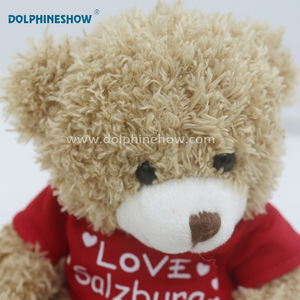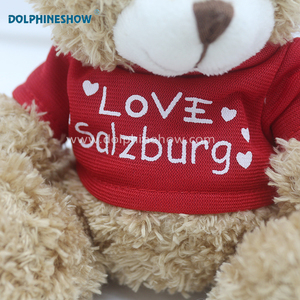
All categories
Featured selections
Trade Assurance
Buyer Central
Help Center
Get the app
Become a supplier

(556 products available)




















































There are various types of brand name for teddy bear, including:
Classic Teddy Bears
Classic teddy bears are known for their timeless construction and appearance. They are often made of plush fabric with soft stuffing, resulting in a huggable texture. These teddy bears have a traditional design that features a rounded face, button noses, and jointed limbs. Their simple elegance has made them favorites for generations.
Character-Inspired Teddy Bears
The Character-Inspired Teddy Bears are replicas of famous personalities from animated television series, films, and literature. These bears are imitations of characters like Winnie the Pooh or Paddington Bear. They normally come with distinctive attributes, such as unique colors, clothing, and symbols that fans can easily recognize. This type offers an emotional bond and nostalgia for their followers.
Personalized Teddy Bears
Personalized teddy bears usually come customized with names, special messages, or unique dates that are embroidered or printed on them. Their personalization nature makes them excellent gifts for special occasions, such as birthdays, anniversaries, or graduations. These bears develop a sense of individuality and emotional attachment, making them sentimental keepsakes.
Miniature Teddy Bears
Miniature teddy bears are small replicas of the classic ones. They can be carried around easily. They have a similar design and appearance as the large ones, but with small sizes. They are usually used as keychain accessories or added to other collections. For instance, some people place them on car dashboards.
Limited Edition and Collector's Teddy Bears
These bears are developed in limited quantities and are often associated with particular events, anniversaries, or collaborations. They are usually tagged with unique characteristics, such as special designs, numbered certificates of authenticity, and signs by their creators. Their scarcity and exclusivity make them highly appreciated by devotees and collectors.
Choosing the right name for a teddy bear brand is a big step that shapes the brand's identity and how customers see it. A cool name can make people remember it and feel good about it, while a not-so-cool name might not connect with them. Therefore, it's crucial to pick a name that truly reflects what the teddy bear represents and connects with the feelings and values of the people who will buy it.
The right name for a teddy bear brand should capture the essence of the product, evoke emotions, and reflect the brand's values. A name that resonates with customers on an emotional level can create a strong bond between them and the plush bear. It should also align with the brand's ethical standards, such as sustainability and fair practices, to meet modern consumers' expectations for social responsibility.
The brand name should be easy to say and remember. It should sound nice when spoken and stick in people's minds without being weird or hard to pronounce. Also, before settling on a name, one must ensure no other company uses it, especially in the same toy market. This avoids legal issues and makes it easier to register trademarks and secure domain names. The brand name should also be flexible enough to allow for future expansion into new product lines or markets without sounding out of place.
Choosing a name for a teddy bear brand is not a one-time thing. It requires thorough research, creativity, and thoughtful consideration of various factors. The process involves brainstorming ideas, getting feedback from others, and even testing them out on potential customers to see how they react. Ultimately, the perfect name will capture the brand's essence and connect with its target audience in a meaningful way.
Teddy bears are stuffed animals that resemble bears. They are commonly given to children and used for decorative purposes. Below are their functions, features, and designs.
Teddy bears are primarily given to children as companions. They offer comfort, especially to children going through a hard time. This is because; they act as a friend that is always available to play with. The bear is also used for decorative purposes in adult bedrooms and living rooms. They come in various sizes and colors, which makes them ideal for different spaces.
Soft and Cuddly
Teddy bears are soft, huggable, and gentle on the skin. The softness is obtained from the materials used in making the bear. This includes woolen yarns, plush fabrics, and cotton. The materials are also hypoallergenic. This ensures that even people with allergies can comfortably use the bear.
Fluffy
The fluffy texture of teddy bears makes them even more comfortable. The fluffiness is achieved from synthetic fibers and stuffing materials such as polyester. The bears can be washed without losing their fluffiness.
Personalization
Teddy bears can be personalized in many ways. This includes putting a child's name on the bear or writing a special message. They can also be customized to resemble a specific person. This is done by choosing the bear's color, size, and clothing.
Classic Design
Most teddy bears are designed to have simple shapes. They are designed to look like bears, with rounded ears, eyes, and noses. The eyes and noses are often stitched to prevent choking hazards.
Clothing
Some teddy bears come when wearing clothes. The clothing can be customized based on the season. For instance, teddy bears can be dressed in sweaters during winter. Accessories like hats and scarves can also be added. Some clothing can be personalized by putting a name or message.
Colors
The most common color of teddy bears is brown. They can, however, come in many other colors such as white, grey, and pink. This allows people to choose a bear that can blend into any space.
Following are some of the common safety features that may be found in teddy bears:
Non-Toxic Materials
Teddy bears are often made of materials that do not contain harmful chemicals. This ensures that if children put them in their mouths, they will not be harmed.
Hypoallergenic Fabrics
Some teddy bear fabrics are designed to keep people from having allergic reactions. This makes it less likely that a child with allergies will have a bad reaction when they hug or play with the bear.
No Small Parts
The teddy bear should not have tiny pieces that could come loose and make it hard for a child to swallow. This includes buttons, eyes, or any decorative pieces. If the teddy bear has these parts, they should be stitched securely so they cannot come off.
Safety Standards Compliance
Teddy bears should be made according to safety rules set by groups like the Consumer Product Safety Commission (CPSC). These rules help keep kids safe by making sure toys are made well.
Soft and Durable Seams
The teddy bear's seams, which are like its stitches, should be soft and tough so that no loose pieces can come off. Kids can hug the bear tight, and the seams won't break.
Teddy bears are usually made from high-quality materials that make them soft, huggable, and long-lasting. The outer fabric is often plush and feels good to the skin. It is usually made from cotton, polyester, or a mix of both. This makes the bears comfortable to cuddle. To ensure that the stuffing inside the teddy bears does not come out, they often use a special material called 'polyfill.' It is lightweight and keeps the bears fluffy. Some high-end bears even have materials that make them feel warmer, like the 'minky' fabric. This gives them a unique, cozy feel.
Teddy bears are usually well-made, which means their seams and stitches are strong and even. This quality construction means they won't fall apart, even if a child plays with them a lot. The eyes and nose of the teddy bears are safely attached, so they won't come off and make a child swallow them by mistake. Some teddy bears have extra features like being washable in a machine if they get dirty. This is helpful because kids can be messy. Higher-end teddy bears may have even more quality features. They might be made from materials that won't cause allergies or have a special smell that makes them feel like a friend. Some bears are also made in a way that makes them safer for younger kids to play with.
Q: Can a brand name for a teddy bear be changed later?
A: While it's possible to change a teddy bear's brand name, rebranding can be costly and complicated. It might be worth taking the time to choose a name that fits well and will last from the start.
Q: How important is it to check if a brand name is already taken?
A: Very important! Before settling on a name, do a thorough trademark search to ensure no one else has it. This could save legal trouble down the road.
Q: Is it okay to use a made-up word as a brand name for a teddy bear?
A: Absolutely! Many successful companies like "Kodak" and "Google" use made-up words because they're unique and memorable. Just ensure the word sounds good and fits the bear's personality.
Q: What if the teddy bear has multiple personalities or styles?
A: If a bear comes in different personalities, consider naming them in a way that shows that. For example, if the bear is named "Cuddly," other bears in that line could be named "Cuddly's Friends."
Q: How can storytelling boost a teddy bear's brand name?
A: A great story can make customers feel more connected to the bear. Share tales about the bear's "adventures" or how it "came to be." This adds charm and makes the brand memorable.